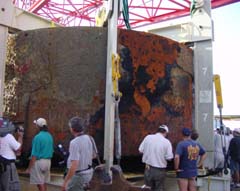| NOAA Magazine || NOAA Home Page |
RESEARCHERS TO USE INFRARED LASER-SCAN TO CREATE 3-D MODEL OF THE USS MONITOR’S TURRET AND STEAM ENGINE
 May
12, 2004 — This week in Newport News, Va., The Mariners’ Museum
and the NOAA Monitor National Marine
Sanctuary are working with the National Park Service’s Historic
American Buildings Survey/Historic American Engineering Record (HABS/HAER)
to map the Civil War ironclad USS Monitor’s turret and steam engine
using advanced laser scanning equipment. The documentation is part of
the ongoing treatment process for these and hundreds of other USS Monitor
artifacts undergoing conservation at The Mariners’ Museum. (Click
NOAA photo for larger view of USS Monitor turret after it was brought
onboard the Derrick Barge Wotan on August 5, 2002. Click
here to view high resolution version. Please note that this is a large
file. Please credit "NOAA.")
May
12, 2004 — This week in Newport News, Va., The Mariners’ Museum
and the NOAA Monitor National Marine
Sanctuary are working with the National Park Service’s Historic
American Buildings Survey/Historic American Engineering Record (HABS/HAER)
to map the Civil War ironclad USS Monitor’s turret and steam engine
using advanced laser scanning equipment. The documentation is part of
the ongoing treatment process for these and hundreds of other USS Monitor
artifacts undergoing conservation at The Mariners’ Museum. (Click
NOAA photo for larger view of USS Monitor turret after it was brought
onboard the Derrick Barge Wotan on August 5, 2002. Click
here to view high resolution version. Please note that this is a large
file. Please credit "NOAA.")
“Together, NOAA, The Mariners’ Museum and the National Park Service are using the technology of our time to preserve one of the most revolutionary technologies of all time: the USS Monitor,” said retired Navy Vice Adm. Conrad C. Lautenbacher, Ph.D., undersecretary of commerce for oceans and atmosphere and NOAA administrator. “It’s another step forward in the effort to preserve this important part of America’s maritime heritage.”
“We’re pleased to be working with HABS/HAER to document the turret and steam engine from the USS Monitor,” said John Broadwater, manager of the NOAA Monitor National Marine Sanctuary, which is funding the documentation work. “Their expertise will provide us with an accurate 3-D image of the current state of both artifacts before they begin the conservation process.”
HABS/HAER is an arm of the National Park Service and is an integral component of the federal government’s commitment to historic preservation. HABS/HAER documents important architectural, engineering and industrial sites throughout the United States and its territories.
“The process is expected to take a week and will provide us with a 3-D image of the turret and steam engine as they are right now,” said Curtiss Peterson, The Mariners’ Museum’s lead conservator. “We need detailed documentation of these large complex components of the Monitor before we disassemble them for conservation.”
Once complete, the data will then be translated into a 3-D model of each artifact. According to Broadwater, this type of mapping will need to be performed a few more times throughout the conservation process. The steam engine is expected to take 10 years to conserve and the turret is expected to take 20 years.
In 1862, the Civil War ironclad, USS Monitor sank in turbulent waters off the coast of North Carolina. Almost 100 years later, scientists discovered the wreck, which became the nation’s first national marine sanctuary in 1975. In 1987, NOAA designated The Mariners’ Museum as the repository for artifacts and archives from the USS Monitor.
Since then, The Mariners’ Museum has received more than 1,500 artifacts from the Monitor, including the steam engine in 2001 and the revolving gun turret in 2002. The Mariners’ Museum, in partnership with the NOAA Monitor National Marine Sanctuary, is working to develop the USS Monitor Center, which will become the definitive national authority and repository for materials, research and programming related to the history of the famous ironclad—and the larger story of the naval history of the Civil War.
The Mariners’ Museum is conducting a $30 million capital campaign for construction of the USS Monitor Center. NOAA’s National Marine Sanctuary Program has provided $9.5 million in federal funds toward the $20 million that will be raised from public sources. The Mariners’ Museum is raising $10 million from corporations, foundations, and individuals across the nation. The Center will open on March 9, 2007.
The Mariners’ Museum, an educational, non-profit institution accredited by the American Association of Museums, preserves and interprets maritime history through an international collection of ship models, figureheads, paintings and other maritime artifacts. For information call (757) 596-2222 or (800) 581-7245, or write to The Mariners’ Museum, 100 Museum Drive, Newport News, VA 23606.
The NOAA National Marine Sanctuary Program, which manages the Monitor National Marine Sanctuary, seeks to increase the public awareness of America’s maritime heritage by conducting scientific research, monitoring, exploration and educational programs. Today, the sanctuary program manages 13 national marine sanctuaries and one coral reef ecosystem reserve that encompass more than 150,000 square miles of America’s ocean and Great Lakes natural and cultural resources.
The NOAA Ocean Service manages the NMSP and is dedicated to exploring, understanding, conserving and restoring the nation’s coasts and oceans. The NOAA Ocean Service balances environmental protection with economic prosperity in fulfilling its mission of promoting safe navigation, supporting coastal communities, sustaining coastal habitats and mitigating coastal hazards.
NOAA is dedicated to enhancing economic security and national safety through the prediction and research of weather and climate-related events and providing environmental stewardship of the nationís coastal and marine resources. NOAA is part of the U.S. Department of Commerce.
Relevant
Web Sites
USS
Monitor Recovered and Under Study;
The Civil War Ironclad Reveals its Long-held Secrets
NOAA Monitor National Marine Sanctuary
NOAA Ocean Service
Media
Contact:
David Hall, NOAA
National Marine Sanctuary Program, (301) 713-3125 ext. 229